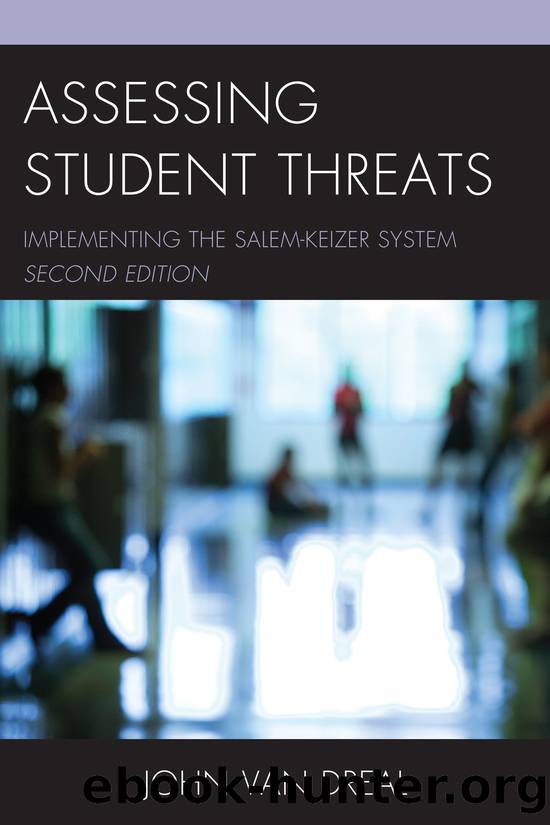Assessing Student Threats by Dreal John Van;

Author:Dreal, John Van;
Language: eng
Format: epub
Publisher: Rowman & Littlefield Publishers
Chapter 10
Communicating Threat-Assessment Outcomes
Courtenay McCarthy and John Van Dreal
Assessing and managing threats is extremely important, or you wouldnât be reading this book. Equally important is the manner in which the assessment results and management plan is communicated to school staff, parents/guardians of the student(s) of concern, parents/guardians of any targeted students, and, at times, the community at large. Appropriate communication serves to ensure that school staff and families are aware of safety concerns and that the management plan is carried out and further increases psychological safety through transparency and dialogue.
There is an increasing public demand for information that impacts the safety of students and school staff, and it appears that legislation is moving toward clearing the communication path between public service agencies and education. Safety information that was once contained in silo is now moving between entities as a matter of public safety. Furthermore, there are increased expectations for education systems and public service to provide notice to those at risk.
In providing this sensitive information, there is a constant tension between providing too much detail or too little. Providing too little information can impact safety, while providing too much information can lead to overreaction or even hysteria. The difficulty is that communication is, by nature, more of an art than a science. Therefore, there is no prescriptive approach or âcorrectâ way to share these results but there are factors to consider when doing so. This chapter will discuss considerations in determining who need to know the information obtained, the situational content that should be communicated, and how to share this information effectively.
When considering this subject, teams are often concerned about maintaining confidentiality and complying with the Federal Educational Rights and Privacy Act (FERPA) regulations. Please refer to the chapter on STAT Operations, which addresses the specifics of FERPA. To summarize, information obtained from educational records can be shared in a health and safety emergency in order to protect the health and safety of individuals. In addition, much of the information gained through a threat-assessment process concerns a studentâs communication and behavior, which are shared orally in a Level 1 or Level 2 meeting, and are, therefore, not considered educational records as indicated by the provisions of the law. For these reasons, school staff should not be excessively concerned with sharing relevant aspects of a threat assessment with parties who have a need to know.
Who Needs to Know
Before disseminating information regarding threat-assessment results and/or the developed management plan, consider the information obtained and who is likely to be affected by it. The primary question is: Who is in a position to protect the health and safety of those at risk? The most likely recipients of this communication are school staff, parents/guardians of the student(s) of concern, parents/guardians of the targeted student(s) and, occasionally, the community at large. The following are suggestions on how to determine which specific individuals need to know.
School Staff
Administrators take the lead on threat-assessment processes due to their responsibility for maintaining health and safety needs within their schools. In most cases, they will lead in sharing information with school staff in their buildings.
Download
This site does not store any files on its server. We only index and link to content provided by other sites. Please contact the content providers to delete copyright contents if any and email us, we'll remove relevant links or contents immediately.
The Art of Coaching Workbook by Elena Aguilar(48400)
Trainspotting by Irvine Welsh(20104)
Twilight of the Idols With the Antichrist and Ecce Homo by Friedrich Nietzsche(17733)
Fangirl by Rainbow Rowell(7860)
Periodization Training for Sports by Tudor Bompa(7357)
Change Your Questions, Change Your Life by Marilee Adams(6679)
This Is How You Lose Her by Junot Diaz(5819)
Grit by Angela Duckworth(4759)
Red Sparrow by Jason Matthews(4706)
Asking the Right Questions: A Guide to Critical Thinking by M. Neil Browne & Stuart M. Keeley(4619)
Paper Towns by Green John(4188)
Room 212 by Kate Stewart(4132)
Ken Follett - World without end by Ken Follett(3990)
The Sports Rules Book by Human Kinetics(3611)
Housekeeping by Marilynne Robinson(3437)
The Motorcycle Diaries by Ernesto Che Guevara(3360)
Introduction to Kinesiology by Shirl J. Hoffman(3315)
Exercise Technique Manual for Resistance Training by National Strength & Conditioning Association(3315)
Double Down (Diary of a Wimpy Kid Book 11) by Jeff Kinney(3296)
